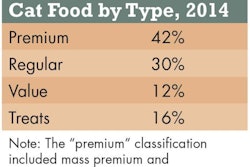With sales reaching US$73 billion in 2014, the US pet products and services market is continuing its upward trajectory on the strength of several important industry trends. According to US Pet Market Outlook, 2014-2015, a report by market research firm Packaged Facts, the trends include, but are not limited to:
- An uptick in dog- and cat-owning US households
- An aging pet population and obesity among pets
- The purchase of pet products online grew 38% in 2014 with a particular boost to pet medications
US Pet Market Outlook, 2014-2015 draws from the results of Packaged Facts' Pet Owner Survey.
The percentage of households owning any pet has increased slightly over the past few years, according to Packaged Facts. Today, 45 million US households own dogs, and 30 million households own cats. While the US dog population is growing, the size of the animals is smaller. Packaged Facts' Pet Owner Survey indicates that a higher percentage of US households have small dogs (under 25 pounds) than medium dogs (25-40 pounds) or large dogs (40+ pounds), with the figures at 52%, 32% and 42%, respectively. The percentage of pet owners with small and large dogs increased slightly, while those with medium dogs held steady.
Packaged Facts expects the shift to smaller dogs to continue in the years ahead, with the aging human population as a key driver. Further, the shift to smaller dogs could have numerous ramifications for the US pet market. Since smaller dogs eat less, petfood marketers may find it harder to increase volume sales. At the same time, size- and breed-specific foods could make up for that slack.
Approximately 45% of dog owners have a dog age seven or older, while 46% of cat owners have a cat in that oldest age bracket, according to the Packaged Facts Pet Owner Survey. The growing population of older pets means more companion animals are suffering from age-related conditions including joint, coronary, cognitive and immune-system-related, as well as diabetes and cancer. Senior-targeted pet products cover all of these needs as well as routine daily concerns, and because of their more specialized health focus, senior products and services are typically priced well above the market average.
Data reveals that 52% of dogs and cats in the US are obese. As long as this remains the case, there will continue to be market potential for products aimed at helping pets reach or maintain a healthy weight.

















